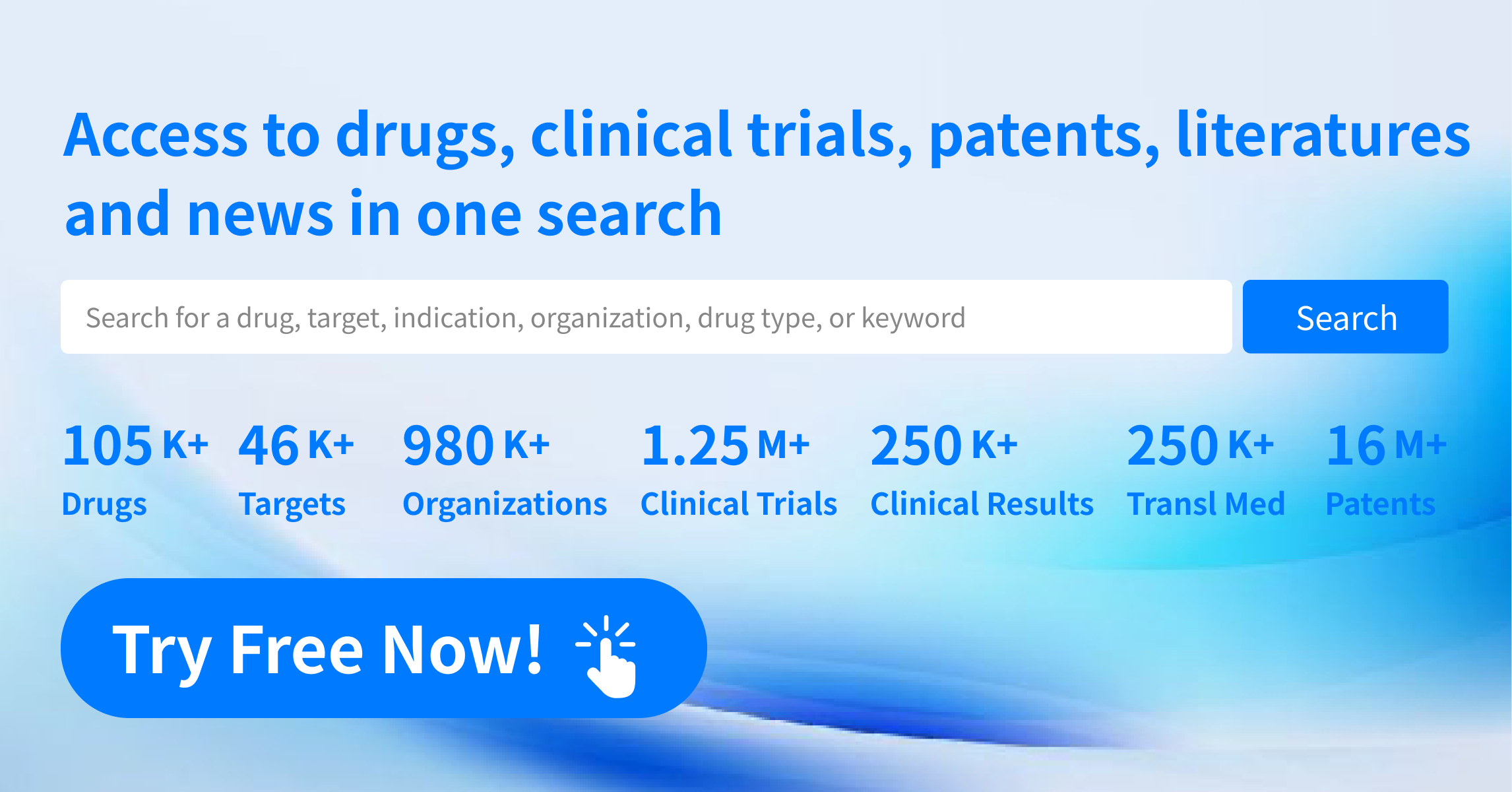Claudin18.2: A Promising Target for Precision Therapies in Gastric and Pancreatic Cancers
In the forefront of oncology, scientists have been tirelessly searching for new weapons capable of precisely targeting cancer cells without harming healthy tissues. In recent years, a molecular target known as Claudin18.2 has emerged as a prominent target in the treatment of gastric cancer, pancreatic cancer, and various other solid tumors. As a member of the tight junction protein family, Claudin18.2 is normally expressed exclusively in differentiated gastric mucosal epithelial cells, while exhibiting highly specific overexpression in several cancers, including gastric and pancreatic cancers. This unique expression pattern makes Claudin18.2 an ideal target for anticancer drug development.
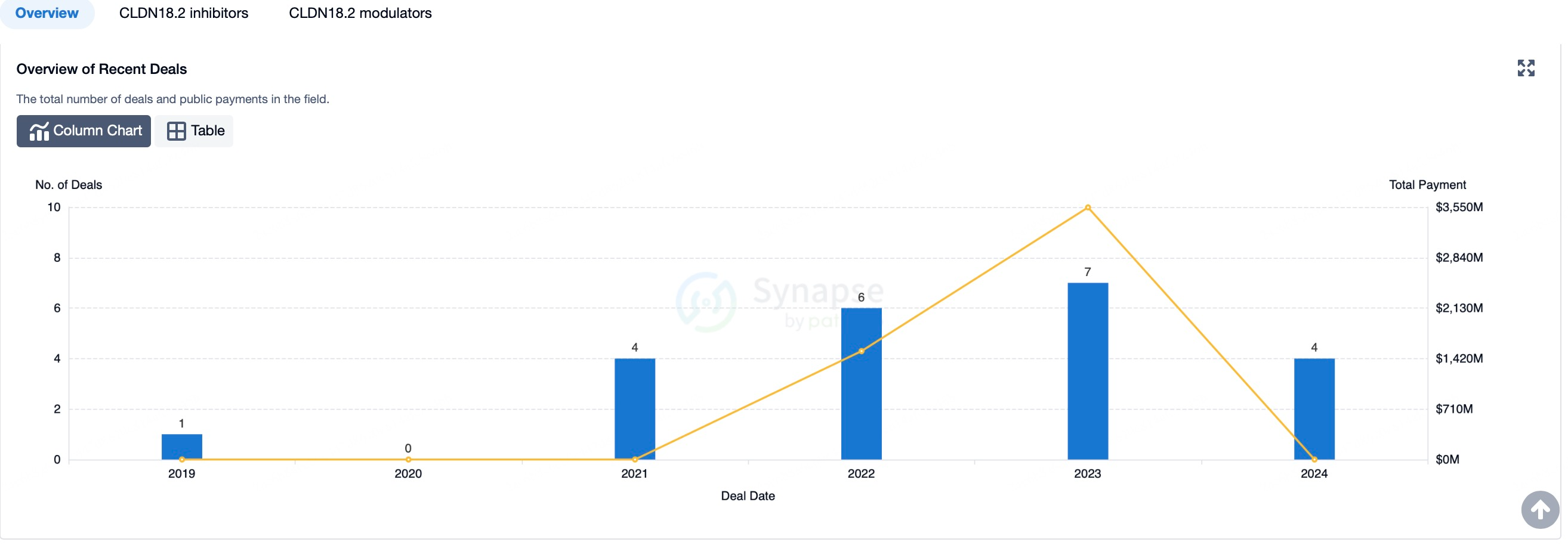
Mechanism of Action for Targeting Claudin18.2
Claudin18.2 is a member of the Claudin protein family, which constitutes an essential component of tight junctions (TJs). The Claudin family comprises at least 27 members whose primary function is to form barriers between cells, maintaining tissue polarity and selective permeability. Claudin18.2 is encoded by the CLDN18 gene and features four transmembrane domains (TM1–4), intracellular N-terminal and C-terminal ends, and two extracellular loops (ECL1 and ECL2). ECL1 contains four β-strands and an extracellular helix (ECH), while ECL2 includes one β-strand and a partially membrane-exposed extracellular segment. These structural features enable Claudin18.2 to form selective permeability barriers between cells, supporting the polarity of gastric epithelial cells.
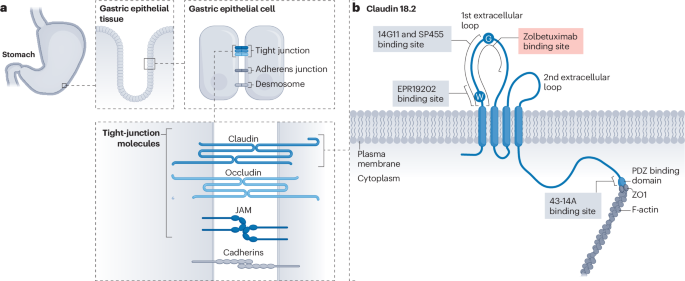
Under normal conditions, Claudin18.2 is expressed at low levels in the differentiated epithelial cells of the gastric mucosa, where it primarily functions to facilitate intercellular connections and maintain barrier integrity. However, during the malignant transformation of gastric mucosal epithelial tissues, disruptions in cell polarity expose the Claudin18.2 epitopes on the cell surface, making it a potential therapeutic target.
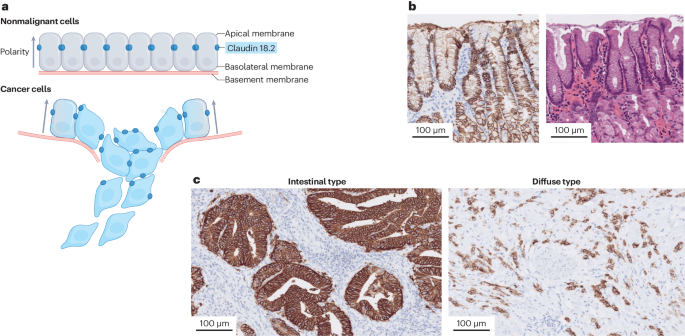
As a critical component of intercellular tight junctions, Claudin18.2 primarily functions to preserve intercellular barrier integrity. However, in specific cancer types—particularly gastric cancer—the expression profile of Claudin18.2 differs significantly from that in normal tissues. During the malignant transformation of gastric mucosal epithelial tissues, the loss of cell polarity exposes the Claudin18.2 epitopes on the cell surface. This phenomenon not only positions Claudin18.2 as a promising therapeutic target for gastric cancer but also provides new perspectives for developing targeted therapeutic strategies.
The Role of Claudin18.2 in Tumors
The aberrant expression of Claudin18.2 is closely associated with the progression of various cancers. In normal tissues, Claudin18.2 is primarily restricted to differentiated epithelial cells in the gastric mucosa. However, in tumor tissues, the expression level of this protein is significantly elevated. More importantly, the epitopes of Claudin18.2 on the surface of tumor cells become readily accessible to antibodies under pathological conditions, enabling the potential for specific targeted therapies. The high expression of Claudin18.2 can enhance tumor cell adhesion and communication with surrounding cells, influencing cellular growth, proliferation, and metastasis. For instance, the overexpression of Claudin18.2 may promote tumor cell proliferation through the activation of signaling pathways such as PI3K/Akt and MAPK.
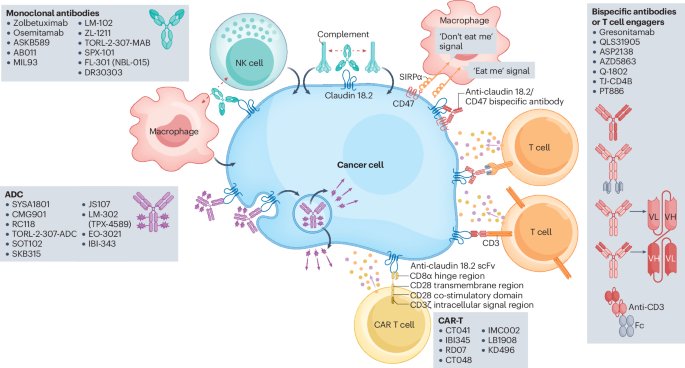
Zolbetuximab is a monoclonal antibody targeting Claudin18.2 that specifically binds to the Claudin18.2 protein on the surface of tumor cells. Claudin18.2 is highly expressed in various cancers, especially gastric cancer, pancreatic cancer, and lung cancer. Zolbetuximab exerts its therapeutic effect primarily by inducing antibody-dependent cellular cytotoxicity (ADCC), activating natural killer (NK) cells and other immune cells, such as macrophages and neutrophils. These immune cells directly kill antibody-bound tumor cells by releasing cytotoxic granules (e.g., perforin and granzymes) or expressing death ligands (e.g., FasL). Additionally, Zolbetuximab enhances the killing of tumor cells through complement-dependent cytotoxicity (CDC) and apoptosis-inducing mechanisms.
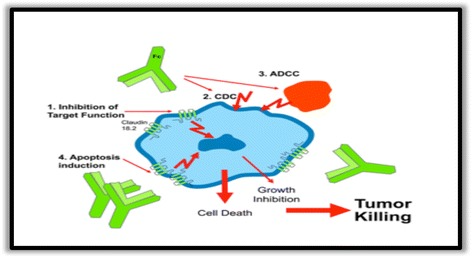
When combined with certain immunomodulatory agents (e.g., zoledronic acid and interleukin-2), Zolbetuximab can activate and expand immune cell populations associated with ADCC, such as γδ T cells and NK cells, thereby augmenting the immune response against tumors. Furthermore, when used in combination with chemotherapy agents, Zolbetuximab promotes T-cell infiltration and induces the production of pro-inflammatory cytokines, leading to enhanced therapeutic efficacy.
As an ideal tumor-specific target, Claudin18.2 enables the development of precision therapies that selectively attack tumor cells while minimizing damage to normal tissues, thereby improving the safety and efficacy of cancer treatment.
Clinical Trial Results on the Antitumor Activity of Zolbetuximab
In two pivotal Phase III clinical trials, SPOTLIGHT and GLOW, Vyloy (zolbetuximab) combined with chemotherapy significantly improved patient survival rates. Specifically, in the SPOTLIGHT trial, the median progression-free survival (PFS) for the Vyloy combined with mFOLFOX6 chemotherapy group was 10.61 months, compared to 8.67 months for the placebo group (p<0.0001). In terms of median overall survival (OS), the Vyloy group reached 18.23 months, significantly surpassing the placebo group's 15.54 months (p=0.0013). In the GLOW trial, the median PFS for the Vyloy combined with CAPOX chemotherapy group was 8.21 months, while the placebo group's was 6.80 months (p=0.0002). The median OS was 14.39 months, markedly better than the placebo group's 12.16 months (p=0.0133). These data indicate that Vyloy can significantly delay disease progression and extend patient survival.
In both the SPOTLIGHT and GLOW trials, the safety profile of Vyloy combined with chemotherapy was consistent with the known safety profiles of mFOLFOX6 and CAPOX regimens, with no new safety concerns observed. This provides a strong foundation for the widespread clinical application of Vyloy. Patients receiving Vyloy treatment can maintain a high quality of life while attaining significant therapeutic benefits. This is particularly important for patients with advanced gastric cancer, who often need to consider the impact of treatment on their quality of life.
The SPOTLIGHT and GLOW trials encompassed patients from different regions and backgrounds, indicating the universality of Vyloy's therapeutic effects, making it suitable for a variety of HER2-negative, CLDN18.2-positive gastric cancer patients. This broad applicability positions Vyloy as a promising treatment option that can benefit a wider range of gastric cancer patients. Whether in Asia, Europe, or North America, Vyloy has shown significant therapeutic effects, laying the groundwork for its global promotion and application.
Research and Development Landscape of Claudin18.2
Claudin18.2, a target highly expressed in various tumors, has garnered the attention of multiple global pharmaceutical companies and research institutions. Currently, there are 92 drug candidates targeting Claudin18.2 in development, encompassing monoclonal antibodies, bispecific antibodies, antibody-drug conjugates (ADC), and CAR-T cell therapies, with development stages ranging from preclinical to Phase III clinical trials. This highlights the enormous potential of this target in the field of cancer therapy.
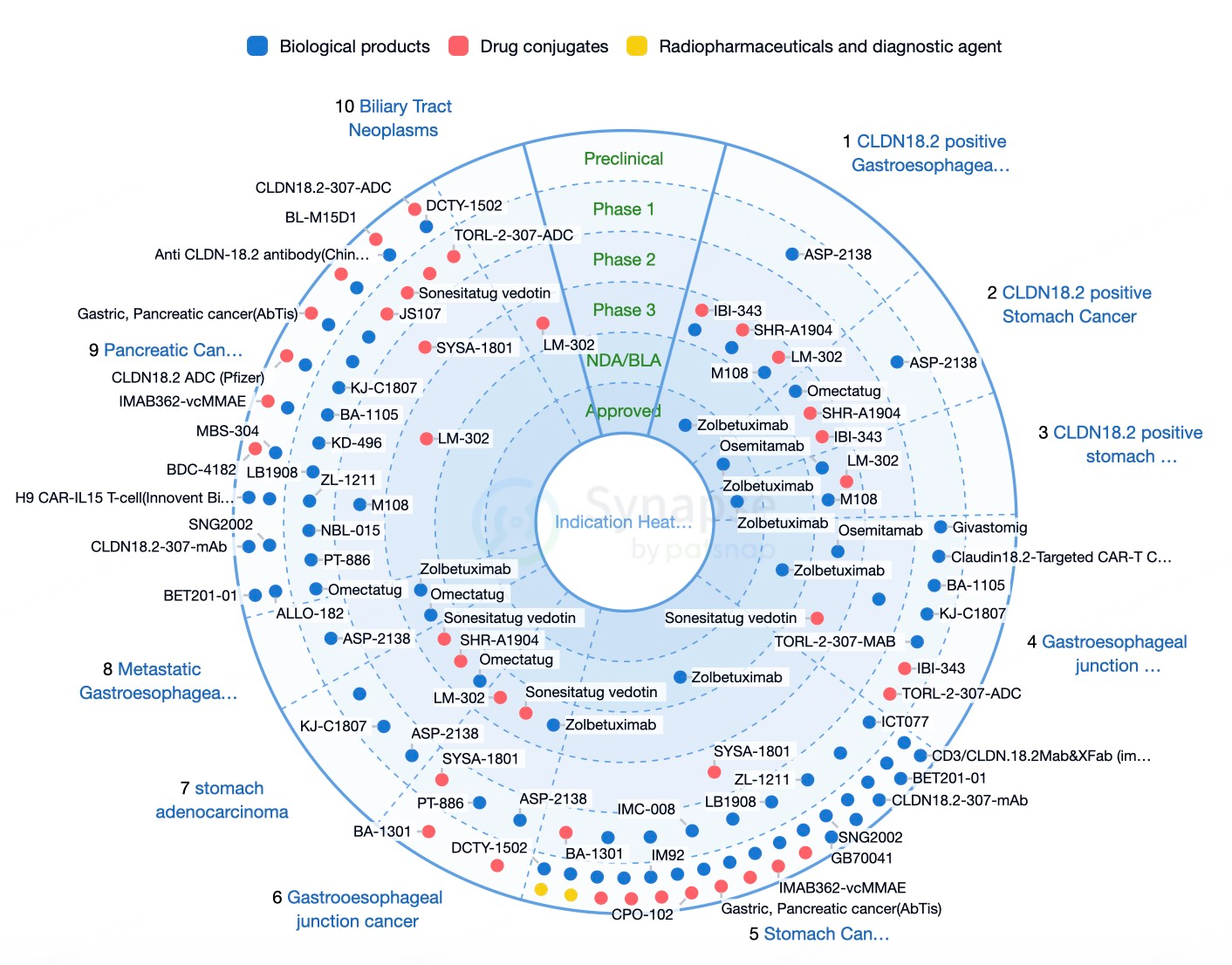
The United States and Europe have maintained significant activity in the research and development of Claudin18.2 targets. The United States has 9 drugs in development, accounting for 10.46% of the global total, primarily concentrated in the fields of monoclonal antibodies and bispecific antibodies. Europe's research and development efforts are relatively less, accounting for approximately 5% of the global total, mainly centered in Germany and the United Kingdom. Other countries such as Japan and South Korea are also conducting related research, but in smaller numbers, mostly in preclinical or early clinical stages. Overall, the Claudin18.2 target is receiving wide attention globally, with China leading the efforts, followed by the United States and Europe.
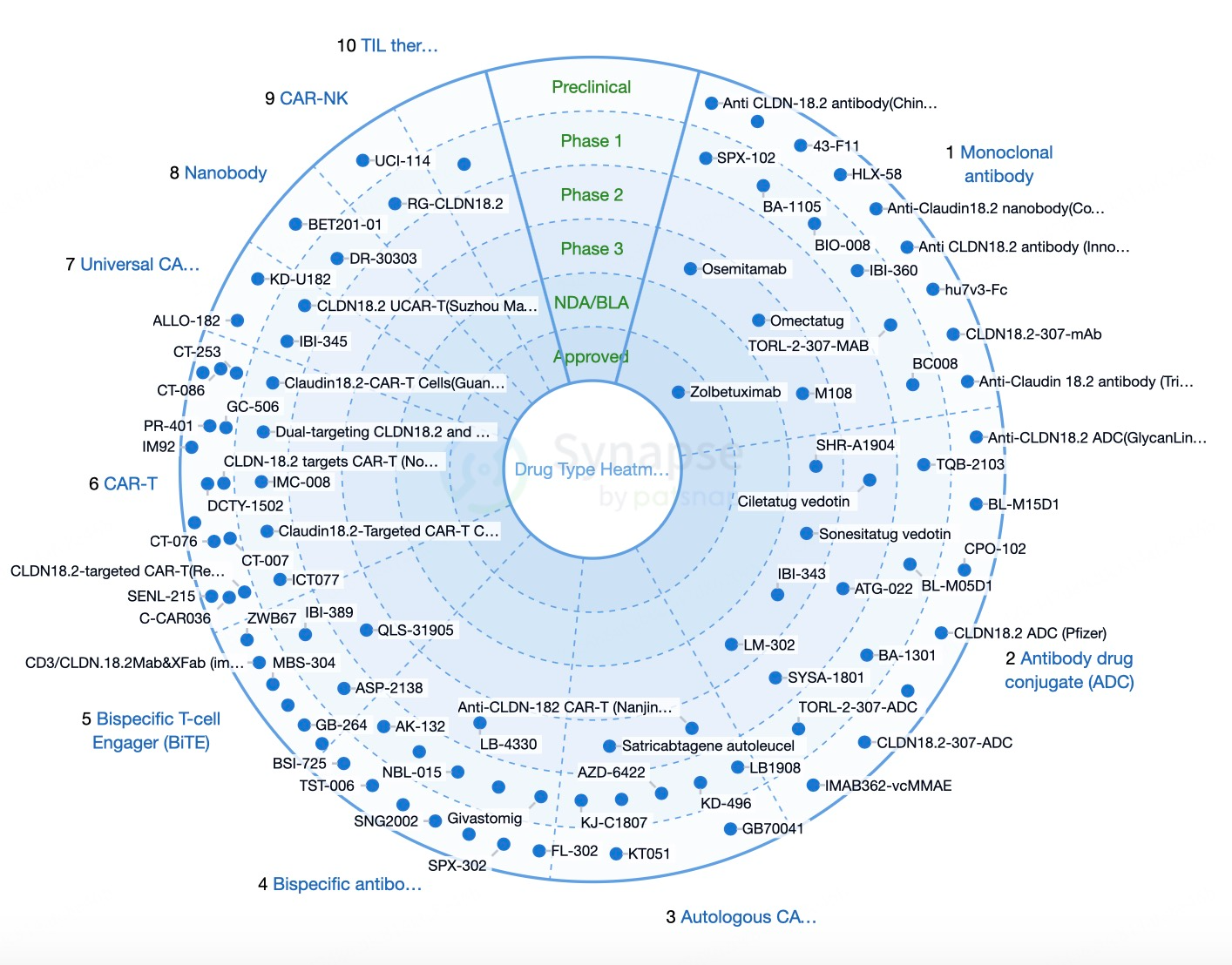
China is at the forefront in the research and development of the Claudin18.2 target, with a total of 70 drugs under development, accounting for 81.4% of the global total. Major companies such as Innovent Biologics, Akeso, RemeGen, and CARsgen Therapeutics have made significant progress in the fields of monoclonal antibodies, bispecific antibodies, ADCs, and CAR-T cell therapies. Some of these drugs have entered clinical trial stages and have shown good safety and preliminary efficacy.
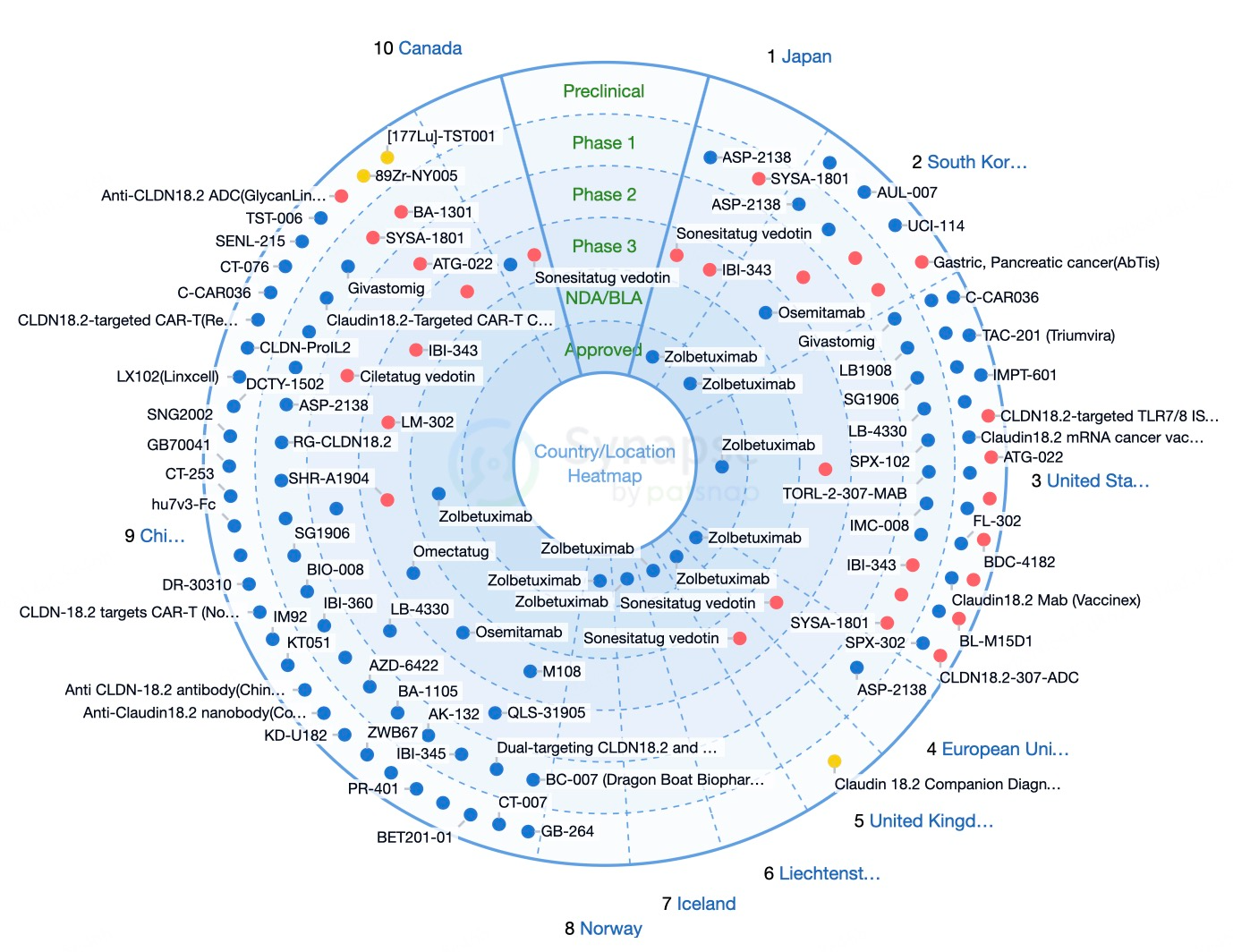
Anti-Cancer Drugs Targeting Claudin18.2
Given the unique expression of Claudin18.2 in tumor cells, multiple targeted therapy strategies are being actively researched and developed, in addition to Zolbetuximab. These strategies include but are not limited to monoclonal antibodies, bispecific antibodies, CAR-T cell therapies, and ADCs.
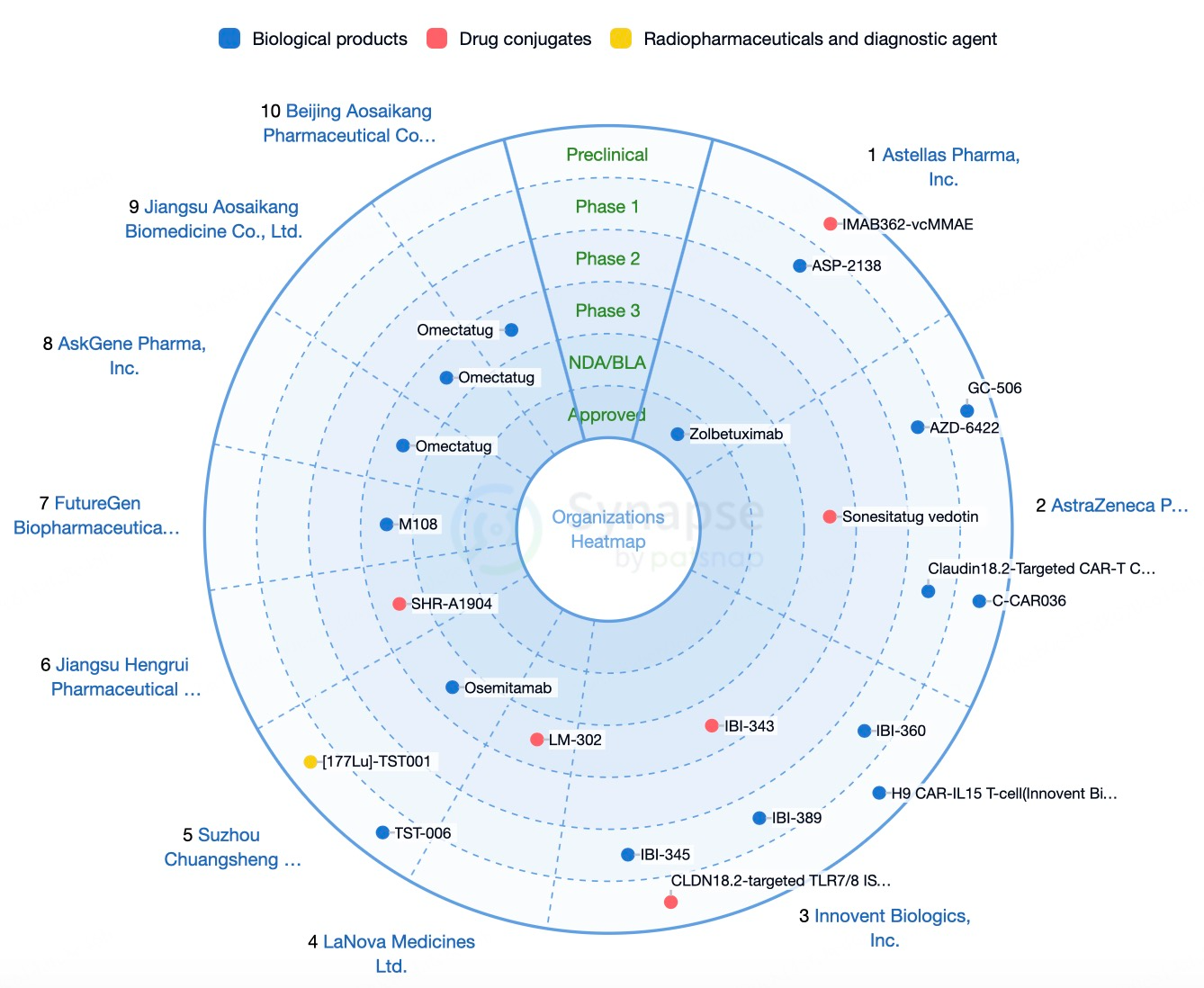
1. antibody-drug conjugate (ADC) SHR-A1904
SHR-A1904 is an ADC independently developed by Hengrui Pharmaceuticals, with a payload of a topoisomerase inhibitor (TOPOi). Its mechanism of action includes: specific binding, where SHR-A1904 specifically binds to antigens on the surface of CLDN18.2 positive tumor cells through its monoclonal antibody component; endocytosis and release, where the bound ADC is internalized by tumor cells, degraded by lysosomes, and releases small molecule toxins; cytotoxic effect, where the released small molecule toxins interfere with DNA replication and repair, leading to tumor cell apoptosis. This design not only enhances the drug's selective cytotoxicity towards tumor cells but also reduces toxicity to normal cells.
2.Bispecific Antibodies (BsAbs) AMG 910
AMG 910 is a bispecific antibody co-developed by Amgen and BeiGene, capable of binding simultaneously to CLDN18.2 and the CD3 molecule on the surface of T cells. Its primary mechanisms include: T cell recruitment, where AMG 910 binds to CLDN18.2 and CD3, recruiting T cells to the vicinity of tumor cells and enhancing T cell-mediated cytotoxicity; immune activation, where the binding of AMG 910 activates T cells, promoting cytokine secretion and further enhancing tumor cell killing capacity. The design of this bispecific antibody aims to improve the specificity and efficiency of immunotherapy, providing a new therapeutic approach for CLDN18.2 positive gastric cancer and other related cancers.
3.Chimeric Antigen Receptor T-cells (CAR-T) CT-041
CT-041 is a CAR-T cell therapy developed by CARsgen Therapeutics, specifically targeting CLDN18.2 positive tumor cells. Its mechanisms include: T cell modification, which involves genetically engineering T cells to express a CAR that specifically recognizes CLDN18.2; tumor cell killing, where the modified CAR-T cells specifically recognize and bind to CLDN18.2 positive tumor cells, directly killing them by releasing cytotoxic granules; immune memory, where CAR-T cells form long-term immune memory in the body, continuously monitoring and destroying recurrent tumor cells. This CAR-T cell therapy provides a new treatment option for patients with CLDN18.2 positive gastric cancer, pancreatic cancer, and other solid tumors, demonstrating good clinical efficacy and safety.
Summary
Despite the enormous potential of targeted therapy against Claudin18.2, several challenges remain. Firstly, accurately identifying patients who might benefit from targeted therapy is an unresolved issue. Different studies use varied detection methods and positive criteria, which may lead to difficulties in determining positive results in clinical practice. Secondly, overcoming tumor resistance and improving treatment efficacy is another focal point for future research. In conclusion, the specific expression of the Claudin18.2 protein in gastric and various other tumors provides a solid theoretical foundation for its use as a therapeutic target. With the continuous advancement of related research and technology, targeted therapy against Claudin18.2 is expected to bring benefits to more patients and open a new chapter in precise oncology treatment.
How to obtain the latest research advancements in the field of biopharmaceuticals?
In the Synapse database, you can keep abreast of the latest research and development advances in drugs, targets, indications, organizations, etc., anywhere and anytime, on a daily or weekly basis. Click on the image below to embark on a brand new journey of drug discovery!
Refrence:
- 1.Mullard A. FDA approves first claudin-18.2-targeted antibody for gastric cancer. Nat Rev Drug Discov. 2024 Oct 22. doi: 10.1038/d41573-024-00172-7. Epub ahead of print. PMID: 39438629.
- 2.Nakayama I, Qi C, Chen Y, Nakamura Y, Shen L, Shitara K. Claudin 18.2 as a novel therapeutic target. Nat Rev Clin Oncol. 2024 May;21(5):354-369. doi: 10.1038/s41571-024-00874-2. Epub 2024 Mar 19. PMID: 38503878.
- 3.Singh P, Toom S, Huang Y. Anti-claudin 18.2 antibody as new targeted therapy for advanced gastric cancer. J Hematol Oncol. 2017 May 12;10(1):105. doi: 10.1186/s13045-017-0473-4. PMID: 28494772; PMCID: PMC5427576.
